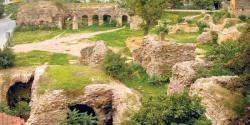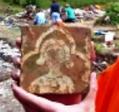- 22 AVRIL
- FRANCE – Rennes - Après quatre semaines de fouilles préalables à la construction de la future station de métro, les archéologues s'apprêtent à quitter la place Saint-Germain. En creusant jusqu'à deux mètres de profondeur, les scientifiques ont trouvé des vestiges de constructions datant du Moyen-Age. « On se doutait qu'il existait un faubourg aux abords de la ville », explique Laurent Beuchet de l'Inrap . « On a retrouvé des murs de petites bâtisses. On imagine que la place ressemblait un peu à la rue Saint-Georges. A certains endroits, on remonte 500 ans d'histoire en creusant 50 centimètres. C'est le plus bel ensemble urbain médiéval qu'on ait trouvé à Rennes », poursuit le spécialiste avec enthousiasme. Après ce premier diagnostic, l'Inrap espère avoir l'autorisation de creuser plus profond, pour savoir si l'endroit était habité à l'Antiquité. « Il y aura probablement des fouilles plus poussées ici et place Sainte-Anne en 2014 », confirme un responsable du Service régional de l'archéologie. « Il faudra creuser jusqu'à six mètres pour remonter plus loin dans le passé », explique l'archéologue.
http://www.20minutes.fr/article/711799/rennes-500-ans-histoire-50-centimetres
- TURQUIE –  Samatya - The Damatrys Palace, built by Emperor Maurice during the days of the Byzantine Empire, will be restored- The Damatrys Palace, which was constructed 14 centuries ago, is located in the Samatya district of İstanbul and is seen to be one of the most important archaeological structures of the Byzantine Empire. The plans for its restoration have identified specific parts of the site as first-degree protected archeological areas, while other sections of the site are identified as third-degree protected archaeological areas. Reports published by the İstanbul Municipality include plans on how the archeological site can be protected. The Sancaktepe Municipality, which the Samatya district falls under, confirms that a contract was signed by the İstanbul Special Provincial Administration for the restoration of the palace. The palace was used as the Byzantine gateway to Anatolia and as a meeting place of the Byzantine army. The emperors also used the palace as a rest stop upon returning from journeys to Anatolia before reaching their capital. It was during the 12th and 13th centuries that the site became unusable due to its dilapidated state. The palace faced the threat of demolition in the 1980s after a large number of migrants settled in Samatya as it had been neglected over the years and was seen to serve little purpose by residents.
Samatya - The Damatrys Palace, built by Emperor Maurice during the days of the Byzantine Empire, will be restored- The Damatrys Palace, which was constructed 14 centuries ago, is located in the Samatya district of İstanbul and is seen to be one of the most important archaeological structures of the Byzantine Empire. The plans for its restoration have identified specific parts of the site as first-degree protected archeological areas, while other sections of the site are identified as third-degree protected archaeological areas. Reports published by the İstanbul Municipality include plans on how the archeological site can be protected. The Sancaktepe Municipality, which the Samatya district falls under, confirms that a contract was signed by the İstanbul Special Provincial Administration for the restoration of the palace. The palace was used as the Byzantine gateway to Anatolia and as a meeting place of the Byzantine army. The emperors also used the palace as a rest stop upon returning from journeys to Anatolia before reaching their capital. It was during the 12th and 13th centuries that the site became unusable due to its dilapidated state. The palace faced the threat of demolition in the 1980s after a large number of migrants settled in Samatya as it had been neglected over the years and was seen to serve little purpose by residents.
http://www.todayszaman.com/newsDetail_getNewsById.action?load=detay&newsId=241484&link=241484
- ROYAUME-UNI – Londres - An archaeological team from Kingston University in South West London has gone beneath the surface of the historic churchyard at the borough's All Saints Church to try to find out more about its history. A church has stood on the grounds for well over 1,000 years and is of great historical significance. It is widely believed to be the site of the crowning of at least two Anglo-Saxon kings, and possibly as many as seven, during the 10th Century, including Athelstan, the first king of a unified England in 925, and Ethelred the Unready in 978-9. Nothing remains above ground of the original Saxon church except for outlines marked by stones outside the south door of the present building. Dr Wickstead was asked by the church to carry out the survey ahead of redevelopment work. "We discovered three possible brick vault structures but have no idea who was actually buried there. Usually they contain coffins of members of a family in an underground chamber," she said. "We know exactly where these vaults are now and we're hoping to use the documentary evidence available -- historical maps, church records and aerial photographs -- to find out who was laid to rest there and precisely when they date from. It would be fascinating to find out their stories."
http://www.sciencedaily.com/releases/2011/04/110421130312.htm
- TURQUIE –  – Istanbul - The closed doors of Turkish Armenian Patriarchate have been opened for two US experts. Archaeology Professor Ronald T. Marchese and Textile professor Marlen R. Breu have now published a book after carrying out 10 years of research, with special permission from Patriarch Mesrop II, on 18th and 19th century textile treasures held by the Istanbul Armenian Orthodox Church. ‘The materials that appears in the book have never been studied before,’ says Marchese-
– Istanbul - The closed doors of Turkish Armenian Patriarchate have been opened for two US experts. Archaeology Professor Ronald T. Marchese and Textile professor Marlen R. Breu have now published a book after carrying out 10 years of research, with special permission from Patriarch Mesrop II, on 18th and 19th century textile treasures held by the Istanbul Armenian Orthodox Church. ‘The materials that appears in the book have never been studied before,’ says Marchese-
http://www.hurriyetdailynews.com/n.php?n=textile-treasures-of-turkish-armenian-patriarchate-revealed-in-a-book-2011-04-21
- ROYAUME-UNI – 
 Shorne - A five-year archaeological dig at Shorne Country Park discovered the remains of Randall Manor, a medieval home, and prehistoric flint tools. The finds, believed to date from the mesolithic period 8,000 years ago, were displayed to visitors at the
weekend.
Shorne - A five-year archaeological dig at Shorne Country Park discovered the remains of Randall Manor, a medieval home, and prehistoric flint tools. The finds, believed to date from the mesolithic period 8,000 years ago, were displayed to visitors at the
weekend.
http://www.gravesendreporter.co.uk/news/archaeology_site_in_shorne_to_become_education_hub_1_872289
- USA –  Lower Makefield - Archaeology is like putting together a jigsaw puzzle without first seeing the finished picture. So says archaeologist John Lawrence, whose team is finding plenty of puzzle pieces to keep them busy in Lower Makefield. Their excavation site next to the Delaware River may look like a jumbled array of dirt, shovels and sifters, but the soil-ridden pieces of stone tools and ceramics that archaeologists are uncovering provide a window into Native American life before European contact. A team of about 15 people who are finding projectile points (arrowheads), tools and pottery dating from about A.D.1000 to A.D.1500. The site near the intersection of River Road and Woodside Road is where a new bridge will replace the Scudder Falls I-95 Bridge linking Bucks and Mercer Counties. There's evidence from a recent archaeological dig across the river in New Jersey that people lived there as far back as 4000 B.C., said Lawrence. On Wednesday, the archaeologists uncovered what appears to be a stone cooking hearth. Team members Jen Marye and Matt Cotter pointed to a cluster of fire-cracked rock sprinkled with small pieces and shards of tempered ceramic pottery, carbon marks from burned fuel and tools made from local shale called argillite, which is still in abundance today. Little orange flags stuck out of the ground to mark each point of interest. The rock cluster may also indicate another way Native Americans cooked, said Lawrence. They may have heated the rocks and placed them inside pots filled with food, effectively cooking it. In another section of the site, a team member scraped an identifier mark around a dark circular patch in the dirt. It may not look like much, but the mark is probably the carbon stain left over from a wooden post or stake that was stuck in the ground. The wood may have been part of some kind of structure, Lawrence said. Several 20-foot-by-10-foot rectangular excavation plots dotted the site. Workers dug to a depth of about 2 to 3 feet, and inside, they meticulously scraped dirt away from artifacts. Pink string criss-crossed one plot, creating a grid that archaeologists can reference later to keep track of where each artifact was found. Stone survived, but anything made of organic matter, such as cloth, wooden structures and bone would leave little or no trace after 500 years. And after this much time, the daily culture of the Native Americans living there is a mystery, Lawrence said.
Lower Makefield - Archaeology is like putting together a jigsaw puzzle without first seeing the finished picture. So says archaeologist John Lawrence, whose team is finding plenty of puzzle pieces to keep them busy in Lower Makefield. Their excavation site next to the Delaware River may look like a jumbled array of dirt, shovels and sifters, but the soil-ridden pieces of stone tools and ceramics that archaeologists are uncovering provide a window into Native American life before European contact. A team of about 15 people who are finding projectile points (arrowheads), tools and pottery dating from about A.D.1000 to A.D.1500. The site near the intersection of River Road and Woodside Road is where a new bridge will replace the Scudder Falls I-95 Bridge linking Bucks and Mercer Counties. There's evidence from a recent archaeological dig across the river in New Jersey that people lived there as far back as 4000 B.C., said Lawrence. On Wednesday, the archaeologists uncovered what appears to be a stone cooking hearth. Team members Jen Marye and Matt Cotter pointed to a cluster of fire-cracked rock sprinkled with small pieces and shards of tempered ceramic pottery, carbon marks from burned fuel and tools made from local shale called argillite, which is still in abundance today. Little orange flags stuck out of the ground to mark each point of interest. The rock cluster may also indicate another way Native Americans cooked, said Lawrence. They may have heated the rocks and placed them inside pots filled with food, effectively cooking it. In another section of the site, a team member scraped an identifier mark around a dark circular patch in the dirt. It may not look like much, but the mark is probably the carbon stain left over from a wooden post or stake that was stuck in the ground. The wood may have been part of some kind of structure, Lawrence said. Several 20-foot-by-10-foot rectangular excavation plots dotted the site. Workers dug to a depth of about 2 to 3 feet, and inside, they meticulously scraped dirt away from artifacts. Pink string criss-crossed one plot, creating a grid that archaeologists can reference later to keep track of where each artifact was found. Stone survived, but anything made of organic matter, such as cloth, wooden structures and bone would leave little or no trace after 500 years. And after this much time, the daily culture of the Native Americans living there is a mystery, Lawrence said.
http://www.phillyburbs.com/news/local/the_intelligencer_news/a-bridge-to-the-past/article_7572df1e-6cd0-11e0-91f8-0019bb30f31a.html